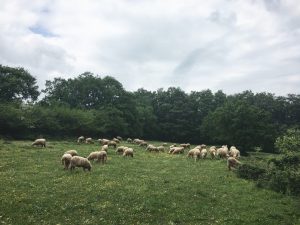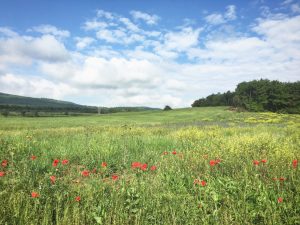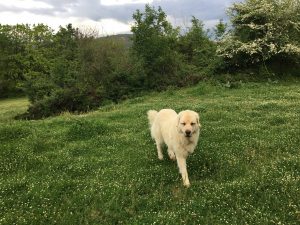
I arrived at Il Campriano on April 30th, where I was greeted with a big smile by Maddelena Cavazzoni at the bus stop in Rosia, the closest village to her house that also has a bus stop. She drove me another 12 km to the final destination, the sheep farm that she and her husband, Claudio, own. Their farm is about a 30 minute drive from the city of Siena, surrounded by rolling hills and forests that open up into beautiful meadows with splashes of vibrant reds, yellows, and purples from wild flowers that paint the landscape. The location is very remote, with few neighbors, and even less cell phone reception. It’s incredibly dreamy, to say the least.
Claudio and Maddalena are originally from Milano, but a little over 30 years ago they were ready to leave city life behind and never look back so they settled in the hills outside of Siena and started making delicious pecorino (sheep cheese). The breed of sheep they raise is Sarda, which is an indigenous breed from the island of Sardinia. Claudio said if you go to Sardinia you would see these sheep all over the place, he chose this breed because of the high volume of milk they produce as well as the quality of the flavor of cheese made from the milk. In the earlier years of their pecorino operation, they had about 200 head of sheep, and he also grew his own hay, stray, and grain. Though, over the last three or so years they have slowly began to wind down and now the heard consists of 56. They have also stopped renewing their organic certification while still maintaining organic practices because the certification costs 800 euros annually (about $950), and due to the longevity of their business their customers know them and don’t need a leaf on the cheese package to trust that they are organic.
Cheese is made once a week, on Wednesday’s. He used to make it more than once a week, but now that the heard is much smaller it’s unnecessary because there is so much involved in the process of making cheese. Before, during, and after cheese making all requires a lot of tedious work, but I’ll get to that in an other post. He makes seven different types of cheeses: fresco, semistagionato, stagionato, Roquefort,ravaggiolo, ricotta, tomino, and eborinato, he also makes yogurt. On Thursday’s, Claudio brings some of his cheese to various shops in near by villages and to a few super markets. On Friday’s he sells his cheese at the market in Siena, which is where I am today. Finally, he attends the Fierucola market in Florence, which I wrote about in a prior blog post. It’s every third Sunday of the month, so I’ll be back at the market on May 20th, which is when I will end my stay at Il Campriano, but that is then and this is now. I still have nine days left with the Cavazzoni family and I’m so excited to get to make cheese for a third time, as well as take more walks through the woods, help with sheep maintenance, wash everything in the creamery many times, and if it doesn’t rain, next Sunday Maddalena and I will be going on a guided hike that her son and his girlfriend, Daniele and Irene respectively, will be leading that consists of walking along a river and stopping for yoga breaks.
In terms of food culture, the order of the food that is eaten and the way it is presented is consistent with family that I stayed with near Lucca. That is,meals start with the main dish, usually pasta or rice, followed by meat (if it’s on the menu), then a salad, other vegetables, bread is eaten between most of the courses to soak up any juices or oil left from the food, and then often times there is desert. This sequence of food is called antipasto, primo, contorno, and dolce. The food is not piled on one plate all at the same time, you eat each course separately (well not always, sometimes a salad and a frittata commingle, but the first course always gets the plate to itself), which allows the eater more time to meditate on each dish. I have noticed that the Cavazzoni’s eat more meat than the Martinelli’s, which Federico had mentioned would likely be the case in southern Tuscany. Of course they eat a lot more cheese than the Martinelli’s, Claudio pulls out a large box from the refrigerator that contains at least 4 types of pecorino for most meals, but not every meal because they don’t want their cholesterol to get too high, so says Maddalena.
Again, I have found such wonderfully hospitable hosts in Toscana. I see many similarities in the mentality of food and the Italian way of living (which I love), but it’s also a very different experience than my last. The farm is much more secluded and there are no children as opposed to the four lively Martinelli girls, and of course the vast difference between vegetable farming and cheese making. I love that I am able to spend time on two wildly different farms at two very different points in their life as a farm. I was a part of the fast paced life where the work never ended at Nico, and now I’m taking it slow as Il Campriano starts to wind down.
I’ll get into the magic of cheese making next time because it really does feel like magic.
Ciao ciao for now!

